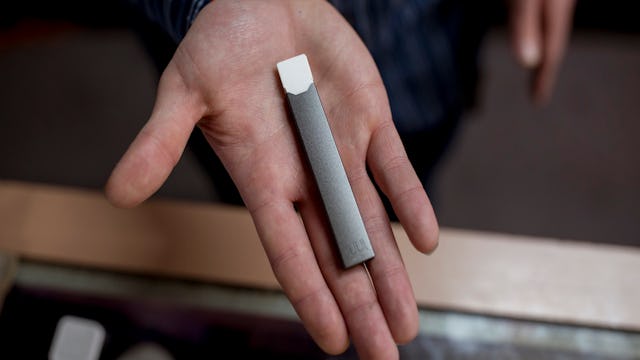FDA Calls Teen E-Cigarette Use An 'Epidemic'

In 2017 alone, e-cigarette sales grew more than 40 percent
If you’re the parent of a tween or teen, you’ve already heard about Juuling, the e-smoking trend that’s increased in popularity so quickly with kids, the U.S. Food and Drug Administration is announcing a new action plan in November to “confront and reverse” youth addiction.
“We have hard data to support the public health tragedy that is now underway,” said FDA Commissioner Scott Gottlieb in a statement. Because of its explosion in popularity and the unusually heavy dose of nicotine it delivers, vaping is considered to be an epidemic amongst teens. But as a parent of a 15 and 13-year-old, I can tell you this phenomenon started much earlier than the teenaged years.
These are battery-powered devices that, according to the CDC, heat “a nicotine-containing liquid to produce an aerosol that is inhaled. Juul’s comes in a variety of flavors, including mango and creme, and also uses nicotine salts, which can allow high levels of nicotine to be inhaled more easily and with less irritation.”
Image via Nielsen
In 2017, the e-cigarette market expanded by 40 percent, to $1.16 billion, with more than half of that being attributed to Juul. What makes it popular with kids is not only the ability to hide the device itself in school and at home, but the “flavors” they’re able to buy (which produce no smoke), make it seem fun and harmless when in fact, one Juul “pod” contains 20 cigarettes worth of nicotine (that’s a pack of regular cigarettes).
Also, some of these “pods” contain zero nicotine at all, which can be what initially gets younger kids hooked. Then, once friends introduce pods with nicotine, it can be hard for them to stop because they’re already fascinated with the process itself. This can also be a way for teens to trick their parents into believing, if caught, that their Juul doesn’t contain anything harmful, it’s “just for fun.” Ask me how I know.
Research found many negative impacts of nicotine alone, including increased cancer risks and respiratory problems, as well as more asthma attacks and symptoms experienced by those who vape. And with Juul sales increasing 641 percent from 2016 to 2017, according to the CDC, it’s being called a “public health concern.”
“The current trends in youth use are not tolerable,” Gottlieb warned. “We have warned for more than a year that the availability of e-cigarettes cannot come at the expense of addicting a generation of youth on nicotine through these products.”
In September 2018, the FDA announced that more than 1,300 warning letters and civil money penalty complaints had been sent to retailers who illegally sold Juul and other e-cigarette products to minors. The FDA is also requesting information from several manufacturers about their marketing practices towards youth and what plans they have to address what they’re calling an epidemic.